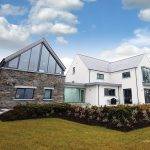The quantity (and price) of each category produced depends on the species and size of the timber being harvested. Timber in Ireland is sold in one of three ways; in a standing sale the timber is sold at the stump – the buyer must fell the tree (thinning and harvesting) and transport it to the mill. In a roadside sale the timber is cut and sold on the forest road, while in a millgate sale the timber is brought directly to the mill.
Manufacture
It is still possible to find small sawmills in Ireland supplying a local market. Indeed, in NI a number of estates and councils with estates have local mills rather than pay a middle person to take it away. However, a large number of sawmills are now geared towards the export market, producing large volumes of timber. In ROI, over half of the sawn timber produced is exported as are over 80% of the wood panels produced. Irish sawmills have their own Chain of Custody certification, which is what enables them to certify their sawn timber products to FSC (or less commonly PEFC) standards.
Once the wood is sawn it is dried to reduce moisture content and then, depending on its end-use, processed further before sale.
Air or kiln drying
Kiln drying is faster than air; for every 25mm thickness of a hardwood you need to allow one year and for softwoods about six months. With most timbers, colour change on kiln drying is negligible, but with very white woods such as sycamore low temperature drying is advisable. Beech can turn pink as a result of deliberate steaming prior to drying but this is not practised in Ireland.
If wood is not properly dried there will be problems such as warping, joints opening, and splitting. The wood surrounding a knot is difficult to work with, end splits on boards are the result of drying too quickly, and shakes are splits that occur naturally during growth or as the result of shrinkage stresses. The rather attractive sounding honeycomb checks are not at all nice to see; these happen when the outside of the board stabilises faster than the inside, tearing the internal fibres.
Timber can contain two types of water: ‘free’ water that sits in the cell cavities, and ‘bound’ water that is contained within the cell walls. Freshly felled oak is high in both, but will lose water from the time it is felled. At the point where it has lost all its ‘free’ water, but still retains its ‘bound’ water, it is at its ‘fibre saturation point’ – in the case of oak this is at a moisture content of around 30%. Below the fibre saturation point, the timber is losing that bound water, and thus could be said to be (to some extent) dry. This is when the timber will start to shrink, and possibly distort. Oak will naturally air dry down to 18%, but below this will need to be kiln dried. ‘Green’ timber is wood ‘that has a moisture content greater than its fibre saturation point’. Often, but not necessarily freshly felled, and usually having rested a while ‘in the round’.
How that timber will behave when drying is a question for skilled and experienced graders. The shrinkage from green timber need not be a problem with good selection, good detailing and the skill of the craftsmen. Buyers beware, and make sure that your suppliers really know their material!
Wood intended for interior use such as furniture or decorative flooring should have a moisture content of between 8% to 12% and should be stored indoors after drying to avoid picking up moisture. For constructional use, the timber is dried to approximately 18%, and when protected from the weather it can be stored outside without picking up moisture. Virtually all of the constructional softwood timber from the large Irish sawmills is kiln dried although fencing and pallet timber may be air dried. Once bought, the important thing from a self-builder’s point of view is to allow the wood to ‘acclimatise’ or get used to the humidity level inside the house for as long as possible. This is especially important if you’re laying floorboards or decorative panels as timber shrinks with heat, which will leave unsightly gaps.





